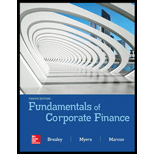
a)
To determine: Current assets.
a)
Explanation of Solution
Note:
Current assets is calculated by adding cash, receivables and inventories.
Calculation of current assets:
Hence, current assets is $100
b)
To determine: Net fixed assets.
b)
Explanation of Solution
Note:
Net fixed assets are calculated by subtracting
Calculation of net fixed assets:
Hence, Net fixed asset is $400.
c)
To determine: Total assets.
c)
Explanation of Solution
Note:
Total assets is calculated by adding the total current assets and net fixed assets.
Calculation of total assets:
Hence, Total assets is $500
Total current assets are taken from part (a) and net fixed assets are taken from part (b) calculation.
d)
To determine: Current liabilities.
d)
Explanation of Solution
Note:
Current liabilities is calculated by adding debt due for payment and payables.
Calculation of current liabilities:
Hence, current liabilities is $60
e)
To determine: Total liabilities.
e)
Explanation of Solution
Note:
Total liabilities is calculated by adding total current liabilities and long term debt.
Calculation of total liabilities:
Hence, total liabilities is $410
f)
To determine: Total liabilities and shareholders equity.
f)
Explanation of Solution
Note:
Total liabilities and shareholders’ equity is calculated by adding total liabilities and shareholders’ equity amount.
Calculation of total liabilities and shareholders’ equity:
So, total liabilities & shareholders’ equity is $500.
g)
To determine: EBIT
g)
Explanation of Solution
Note:
Earnings before interest and tax is computed by deducting COGS, selling and administration expenses and depreciation from Net sales.
Calculation of EBIT:
Hence, EBIT is $70.
h)
To determine: Taxable income.
h)
Explanation of Solution
Note:
Taxable income is calculated by deducting interest expenses from the EBIT.
Calculation of taxable income:
So taxable income is $45.
i)
To determine: Net income.
i)
Explanation of Solution
Note:
Net income is calculated by deducting taxes from the total taxable income.
Calculation of taxable income:
Hence, net income is $30.
Want to see more full solutions like this?
Chapter 3 Solutions
FUNDAMENTALS OF CORPORATE FINANCE
- Forest Enterprises, Incorporated, has been considering the purchase of a new manufacturing facility for $290,000. The facility is to be fully depreciated on a straight-line basis over seven years. It is expected to have no resale value after the seven years. Operating revenues from the facility are expected to be $125,000, in nominal terms, at the end of the first year. The revenues are expected to increase at the inflation rate of 2 percent. Production costs at the end of the first year will be $50,000, in nominal terms, and they are expected to increase at 3 percent per year. The real discount rate is 5 percent. The corporate tax rate is 25 percent. Calculate the NPV of the project. Note: Do not round intermediate calculations and round your answer to 2 decimal places, e.g., 32.16. NPVarrow_forwardHelp with questionsarrow_forwardPlease help with questionsarrow_forward
- Create financial forecasting years 2022, 2023, and 2024 using this balance sheet.arrow_forwardBeta Company Ltd issued 10% perpetual debt of Rs. 1,00,000. The company's tax rate is 50%. Determine the cost of capital (before tax as well as after tax) assuming the debt is issued at 10 percent premium. helparrow_forwardFinance subject qn solve.arrow_forward
 Essentials Of InvestmentsFinanceISBN:9781260013924Author:Bodie, Zvi, Kane, Alex, MARCUS, Alan J.Publisher:Mcgraw-hill Education,
Essentials Of InvestmentsFinanceISBN:9781260013924Author:Bodie, Zvi, Kane, Alex, MARCUS, Alan J.Publisher:Mcgraw-hill Education,

 Foundations Of FinanceFinanceISBN:9780134897264Author:KEOWN, Arthur J., Martin, John D., PETTY, J. WilliamPublisher:Pearson,
Foundations Of FinanceFinanceISBN:9780134897264Author:KEOWN, Arthur J., Martin, John D., PETTY, J. WilliamPublisher:Pearson, Fundamentals of Financial Management (MindTap Cou...FinanceISBN:9781337395250Author:Eugene F. Brigham, Joel F. HoustonPublisher:Cengage Learning
Fundamentals of Financial Management (MindTap Cou...FinanceISBN:9781337395250Author:Eugene F. Brigham, Joel F. HoustonPublisher:Cengage Learning Corporate Finance (The Mcgraw-hill/Irwin Series i...FinanceISBN:9780077861759Author:Stephen A. Ross Franco Modigliani Professor of Financial Economics Professor, Randolph W Westerfield Robert R. Dockson Deans Chair in Bus. Admin., Jeffrey Jaffe, Bradford D Jordan ProfessorPublisher:McGraw-Hill Education
Corporate Finance (The Mcgraw-hill/Irwin Series i...FinanceISBN:9780077861759Author:Stephen A. Ross Franco Modigliani Professor of Financial Economics Professor, Randolph W Westerfield Robert R. Dockson Deans Chair in Bus. Admin., Jeffrey Jaffe, Bradford D Jordan ProfessorPublisher:McGraw-Hill Education





